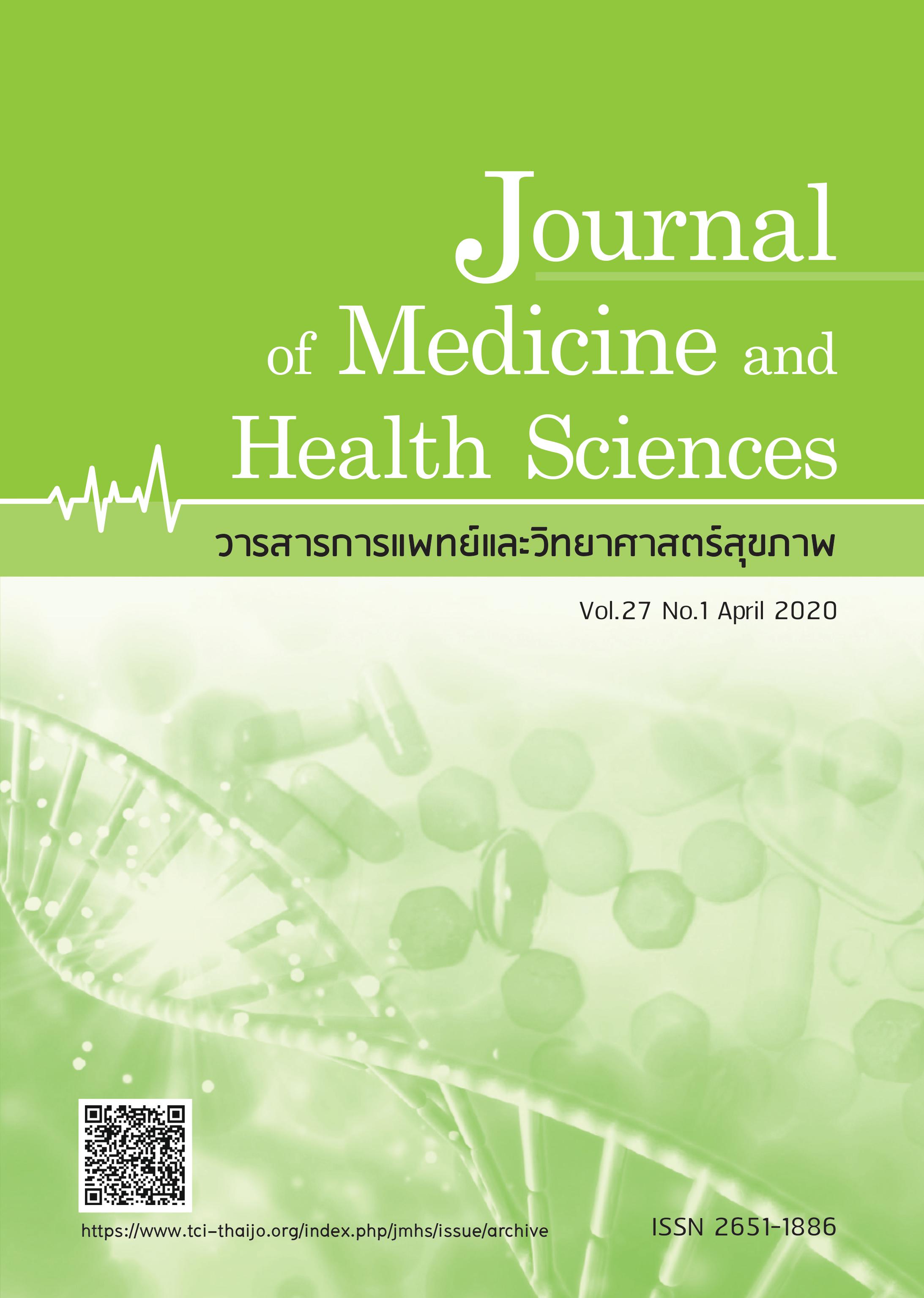Hotspot mutation screening in ATP7B Wilson disease in Thai population by PCR-RFLP
Keywords:
Wilson disease, mutation, ATP7B, PCR-RFLPAbstract
บทคัดย่อ
โรควิลสัน (Wilson disease) เป็นโรคพันธุกรรมที่มีสาเหตุจากการกลายพันธุ์ของจีน ATP7B ถ่ายทอดแบบ autosomal recessive จีน ATP7B เกี่ยวข้องกับกระบวนการเมตาบอลิซึมของทองแดงภายในร่างกาย การกลายพันธุ์ ส่งผลให้เกิดการสะสมของทองแดงในอวัยวะต่างๆ โดยเฉพาะใน ตับ สมอง เป็นสาเหตุให้ผู้ป่วยเกิดภาวะตับอักเสบ ตับแข็ง และความผิดปกติทางระบบประสาท ปัจจุบันสามารถตรวจวินิจฉัยโรควิลสันทางห้องปฏิบัติการด้วยวิธีวิเคราะห์ หาลำดับเบสที่ผิดปกติทั้งหมดของจีน ATP7B ในผู้ป่วย แต่การตรวจวิเคราะห์ดังกล่าวมีค่าใช้จ่ายค่อนข้างสูงจากฐานข้อมูลการกลายพันธุ์ของจีน ATP7B พบตำแหน่งการกลายพันธุ์ที่พบบ่อยในผู้ป่วยโรควิลสันในทวีปเอเชียบน exon 8, 12, 13 การศึกษานี้มีวัตถุประสงค์ เพื่อประยุกต์ใช้เทคนิคพีซีอาร์-อาร์เอฟแอลพีในการตรวจวิเคราะห์คัดกรองตำแหน่งการกลายพันธุ์ของจีน ATP7B ที่พบบ่อย (hotspot mutation) คือ c.2333 G>T (p.Arg778Leu), c.2755 C>G (p.Arg919Gly), c.2975 C>T (p.Pro992Leu) และ c.3443 C>T (p.Ile1148Thr) เพื่อใช้ในการวินิจฉัยเบื้องต้นและค้นหาผู้ที่มีจีนพาหะของโรค (Carrier) โดยทำการศึกษาในตัวอย่างดีเอ็นเอผู้ป่วยโรควิลสันที่ได้รับการวินิจฉัยและยืนยันตำแหน่งการกลายพันธุ์ทั้ง 4 ตำแหน่ง ตำแหน่งละ 1 ราย และตัวอย่างดีเอ็นเอจากประชากรไทยจำนวน 90 ราย โดยการเพิ่มปริมาณสารพันธุกรรมของจีน ATP7B แต่ละตำแหน่งด้วยวิธีพีซีอาร์ และตรวจสอบชิ้นส่วนดีเอ็นเอโดยเอนไซม์ตัดจำเพาะด้วยเทคนิคอาร์เอฟแอลพี จากการศึกษาพบว่าเทคนิคพีซีอาร์-อาร์เอฟแอลพี สามารถจำแนกการกลายพันธุ์ ของจีน ATP7B ในแต่ละตำแหน่งระหว่างผู้ป่วยที่เป็นพาหะและคนปกติได้ จากผลการศึกษา ไพร์เมอร์ และเทคนิค พีซีอาร์-อาร์เอฟแอลพีที่เลือกใช้ สามารถนำมาใช้ในการตรวจวินิจฉัยเบื้องต้นก่อนการส่งตรวจวิเคราะห์หาลำดับเบสที่ใช้เวลานานและมีค่าใช้จ่ายที่สูงกว่า เพื่อใช้ในการวางแผนการมีบุตร และสามารถพัฒนาเป็นเครื่องมือที่ใช้ในงานวิจัย เพื่อหาอุบัติการณ์การกลายพันธุ์ของจีน ATP7B ในประชากรไทยได
Abstract
Wilson disease is inherited in an autosomal recessive pattern. Mutation in ATP7B gene leads to defect in metabolism and deposition of copper in Wilson disease patients. Accumulation of copper in liver, brain and various internal organs contributes to hepatitis, liver cirrhosis and neurological defects. ATP7B is the single causative gene and spans 21 exons. Molecular testing of carrier and patients suspected of Wilson disease requires whole gene DNA sequencing which is cost ineffective and time consuming in Thailand. Mutation database has shown that hotspots of ATP7B mutation in exon 8, 12, 13 are the most prevalent in Asian population. We have developed PCR-RFLP technique for screening of Asian hotspot mutations of ATP7B gene in positions c.2333 G>T (p.Arg778Leu), c.2755 C>G (p.Arg919Gly), c.2975 C>T (p.Pro992Leu) and c.3443 C>T (p.Ile1148Thr). In this study, DNA previously extracted from 4 patients with known ATP7B mutation in hotspots of ATP7B gene and 90 DNA samples from Thai population were tested. DNA samples were amplified by PCR technique then cut with specific restriction enzyme and analyzed by PCR-RFLP technique. The result showed that PCR-RFLP technique can classify point mutations of ATP7B gene in positions c.2333 G>T (p.Arg778Leu), c.2755 C>G (p.Arg919Gly), c.2975 C>T (p.Pro992Leu) and c.3443 C>T between Wilson’s patients carrier and non-carrier Thai adult. This screening method successfully detect mutations in Wilson disease patients and could be used as a screening test in carriers and patients in Thai population with reduced clinical cost and turnaround time in Thailand.
References
2. Dong Y, Ni W, Chen WJ, et al. Spectrum and classification of ATP7B variants in a large cohort of Chinese patients with Wilson’s disease guides genetic diagnosis. Theranostics 2016;6(5):638-49.
3. Ala A, Walker AP, Ashkan K, et al. Wilson’s disease. Lancet 2007;369(9559):397-408.
4. Coffey AJ, Durkie M, Hague S, et al. A genetic study of Wilson’s disease in the United Kingdom. Brain 2013;136(Pt 5):1476-87.
5. Park HD, Ki CS, Lee SY, et al. Carrier frequency of the R778L, A874V, and N1270S mutations in the ATP7B gene in a Korean population. Clin Genet 2009;75(4):405-7.
6. Mak CM, Lam CW, Tam S, et al. Mutational analysis of 65 Wilson disease patients in Hong Kong Chinese: identification of 17 novel mutations and its genetic heterogeneity. J Hum Genet 2008;53(1):55-63.
7. Yoo HW. Identification of novel mutations and the three most common mutations in the human ATP7B gene of Korean patients with Wilson disease. Genet Med 2002;4(6
Suppl):43S-8S.
8. Liu XQ, Zhang YF, Liu TT, et al. Correlation of ATP7B genotype with phenotype in Chinese patients with Wilson disease. World J Gastroenterol 2004;10(4):590-3.
9. Wan L, Tsai CH, Tsai Y, et al. Mutation analysis of Taiwanese Wilson disease patients. Biochem Biophys Res Commun 2006;345(2):734-8.
10. Mak CM, Lam CW. Diagnosis of Wilson’s disease: a comprehensive review. Crit Rev Clin Lab Sci 2008;45(3):263-90.
11. Panichareon B, Taweechue K, Thongnoppakhun W, et al. Six novel ATP7B mutations in Thai patients with Wilson disease. Eur J Med Genet 2011;54(2):103-7.
12. Keandaungjuntr J, Busabaratana M, Kositchaiwat C, et al. Analysis of exon 8 of ATP7B gene in Thai patients with Wilson disease. J Med Assoc Thai 2011;94(10):1184-8.
13. Wei Z, Huang Y, Liu A, et al. Mutational characterization of ATP7B gene in 103 Wilson’s disease patients from Southern China: identification of three novel mutations. Neuroreport 2014;25(14):1075-80.
14. Hua R, Hua F, Jiao Y, et al. Mutational analysis of ATP7B in Chinese Wilson disease patients. Am J Transl Res 2016;8(6):2851-61.
15. Li XH, Lu Y, Ling Y, et al. Clinical and molecular characterization of Wilson’s disease in China: identification of 14 novel mutations. BMC Med Genet 2011;12:6.
16. Huster D, Kuhne A, Bhattacharjee A, et al. Diverse functional properties of Wilson disease ATP7B variants. Gastroenterology 2012;142(4):947-56.
17. Chen C, Shen B, Xiao JJ, et al. Currently clinical views on genetics of Wilson’s disease. Chin Med J 2015;128(13):1826-30.



